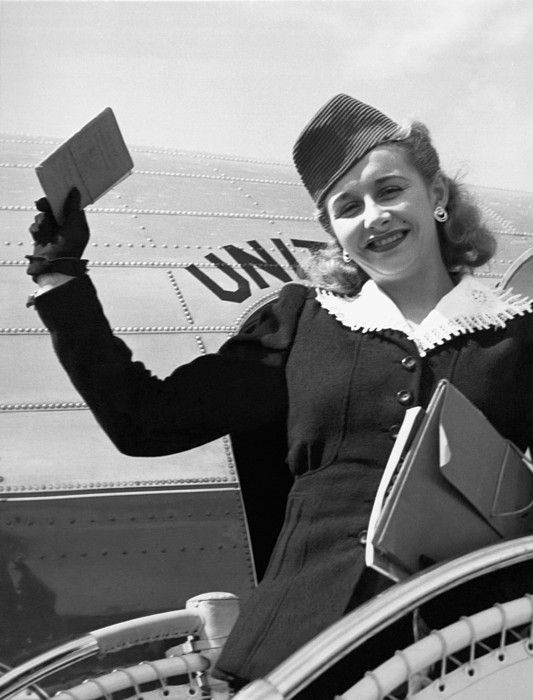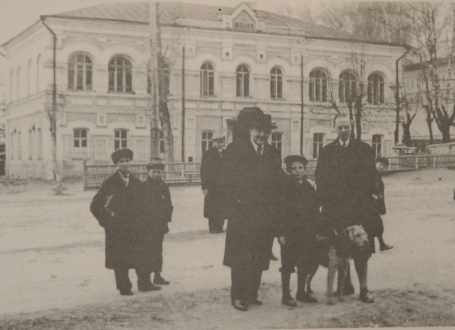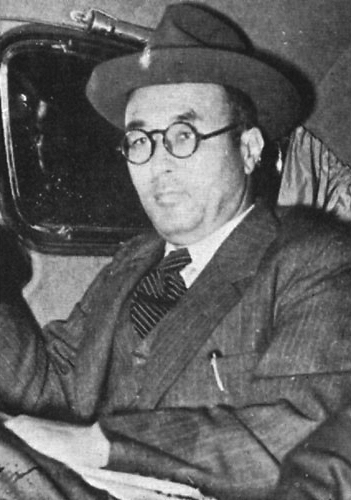Tuesday 8 April 1941
 |
| Land mine damage in Great Yarmouth on April 8, 1941 (Archant Library). |
Belgrade is the prize in Yugoslavia, and Ewald von Kleist wants it. He sends his panzers off at 05:30 toward the city from the northwest. They capture Nis in Serbia and head down the Morava Valley toward the capital. The Yugoslav is giving ground everywhere.
The weather is poor over Belgrade, so the Luftwaffe's Operation Punishment ends today. There is tremendous devastation, but total casualty estimates vary from the as low as 1500 to 17,000. Later estimates of the extent of the damage also vary wildly, with some stating that half of the housing stock is destroyed. Among many other national treasures, the National Library of Serbia is destroyed, along with its medieval manuscripts and other irreplaceable artifacts.
The 1st SS Division Adolf Hitler has moved into the front lines and now sits astride the main railway link between Belgrade and Thessalonica (Thessaloniki). The Yugoslavs in Belgrade now are effectively isolated.
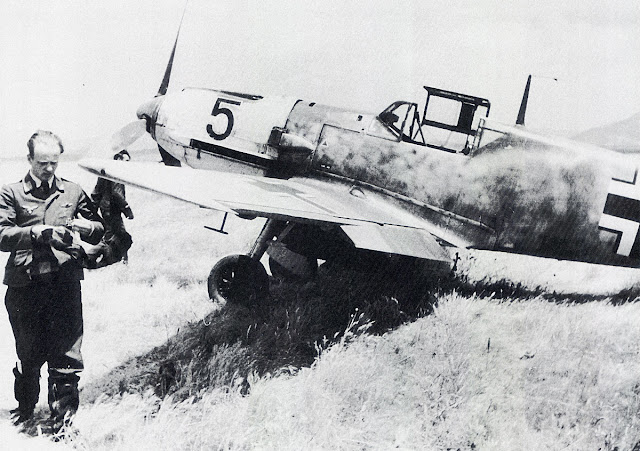 |
| Max Dobislav, who becomes an ace, with his Bf 109E of 8,/JG 27, April 1941. |
The British hurry some of their units (such as the 16th Australian Brigade) forward to support the Greeks on the frontier, but the battle is rapidly becoming a lost cause. The Australians are inexperienced in snow and there is virtually no transport in the mountains they are crossing. The Germans, meanwhile, have mountain troops leading their attack, with the 6th Mountain Division in the vanguard. The 164th Infantry Division captures Xanthi, and the 50th Infantry Division has Komotini and is advancing beyond it.
Strategically, what is happening is obvious on the map. While von Kleist in the north picks apart the internals of the Yugoslav state virtually at his leisure, the panzer forces in southern Yugoslavia have completely bypassed the Greeks and the British to the south. Worst of all for the Allies, the Germans have taken almost no casualties in their drive west through a non-essential portion of the country (from the Yugoslav view). The Greek High Command, of course, notices this, and they put out a communique to that effect which states that the German advance is "exposing the left flank of our brave army."
Some Yugoslav units do see what is going on and take pains to try and prevent it. The 20th "Bregalnička" Infantry Division, part of the 3rd Territorial Army of the Yugoslav army, ties in with the Greeks on the Metaxas Line. It works hard to stop the German 2nd Panzer Division of XVIII Mountain Corps from outflanking the Greek divisions, a task which is vital for the Metaxas Line to have any chance of holding. The 20th Infantry Division, however, can do nothing about the Germans heading due west to the north in what everyone recognizes is a deep flanking maneuver.
Meanwhile, the Yugoslav 3rd Army is fighting well - but headed in completely the wrong direction. While the Germans invade from the north and east, the Yugoslavs are heading... west. In what must have seemed like an extremely clever strategy over holiday dinners, the Yugoslavs intend to defeat the Italians in Albania before turning back around and then dealing with the Germans. This, the strategy posits, would free the mass of the Greek Army stuck in Albania to head east and stop the Germans flooding in from Bulgaria. However, while the Italian Army is weak, it isn't that weak, and in fact, has been dramatically strengthened for their recently concluded Primavera Offensive. The Yugoslavs are making a high stakes gamble based upon the assumption that the Germans can be held at the frontiers until the Italians surrender - a fatal misreading of the situation.
German General Stumme in command of LX Corps, the spearhead cutting east through southern Yugoslavia, is not troubled by any of the Allied moves. He consolidates his grip on southern Yugoslavia and sets his sights on the real prize: the Greek port of Thessalonica (Thessaloniki) not far across the border to the south.
So, some units of the Yugoslav Army do make some progress in the wrong direction. The Yugoslav "Komski" Cavalry Regiment takes the village of Koljegcava in the Valjbone River Valley of Albania, while the 31st "Kosovska" Division breaches the Italian line along the Drin River. However, the Yugoslav High Command begins hedging its bets and recalls the "Vardarska" Division to confront the XL Panzer Corps at Skopje. The Greek Western Macedonian Army Section in Albania also makes some progress toward Durrës, capturing about 250 Italians. However, in strategic terms, the slight gains made by the two armies are meaningless.
The Luftwaffe pays Piraeus another visit, which they are doing every day during this period. They previously virtually destroyed the port on the 6th when they scored a lucky hit on ammunition ship Clan Fraser. Today, the Germans damage 7777-ton Greek tanker Ekaterini Coumantarou.
Yugoslavia, always a tenuous state created out of disparate elements, begins to crumble. Croatian separatists proclaim a new Croatian government in Zagreb. German troops of von Kleist's 1st Panzer Group already are on the city's outskirts. On cue, Croatian soldiers mutiny in Bjelovar. The Luftwaffe quite noticeably is not targeting any Croatian cities, as Croatians tend to favor the Axis over the Allies - as opposed to Serbians, whose cities are getting savaged.
Convoy ASF 24 (five freighters) departs from Piraeus bound for Alexandria. Other convoys at sea are AN 25 and AG 11.
 |
| As during the Polish campaign, early headlines are all favorable to the Allied cause as the Germans sweep through Yugoslavia. LA Times, 8 April 1941. |
RAF Bomber Command, No. 2 Group, continues to focus on Axis shipping. The bombers hit the Kiel Canal with 160 bombers, Bremerhaven with 22 bombers, and shipping off the Danish coast. The RAF also attacks a bridge under construction at Ringkøbing on the west coast of the Jutland peninsula in western Denmark.
Princess Mary visits Hull.
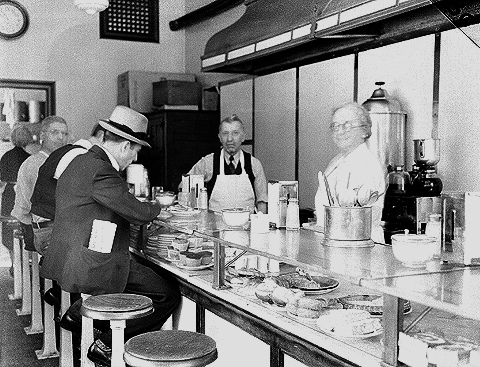 |
| "Coffee shop at 278 10th Avenue in the Chelsea section of Manhattan, April 8, 1941." Photo courtesy of the New York City Housing Authority (NYCHA) photo collection at the La Guardia and Wagner Archives/CUNY. |
The Italians still man the ships in the harbor, and four Italian submarines escape, but the Allies have their eyes on the 17 large merchant ships and many smaller ones anchored there. General Cunningham already has designated the 4th Indian Infantry Division, one of the key components of Operation Compass, for shipment back to Egypt, and he would love to use the port to do it. The port has modern facilities, but the Italians have wrecked the equipment and scuttled ships in the harbor, making it quite a chore for the British to return the port to working order.
After learning of Admiral Bonetti's surrender, the Italian crews of many ships finally bow to the inevitability of the British occupation today and scuttle their ships:
- Destroyer Vincenzo Giordano Orsini
- Torpedo boats MAS 204, 206, 210, 213 and 216
- Italian 11,760-ton passenger ship Colombo
- Italian 3245-ton freighter Clelia Campenella
- Italian 5211-ton tanker Giove
- Italian 4958-ton freighter Prometeo
- Italian coasters San Giorgio (90 tons), Pirano (108 tons), and Trieste (96 tons)
- Italian trawlers Ardita (19 tons) and Sole (15 tons)
These sinkings greatly complicate the British task of putting the port back into service to repair vessels damaged in the conflict in the Mediterranean.
At Addis Ababa, the British occupation forces turn their attention to securing their lines of communication back to Asmara. The Duke of Aosta and his Italian and colonial forces now are bottled up in the mountains and no longer poses an immediate threat even as they continue to hold out. However, at some point, the British will have to flush these troops out.
 |
| "Two NYA workers and a chef prepare meals for other NYA workers at the Los Angeles City Playground and Recreation Center Project, April 8, 1941." Photo courtesy of the National Archives via The Living New Deal). |
- 3314-ton British freighter Helena Margareta (27 deaths, 9 survivors, Captain Owen T. Jones gets the Lloyd's War Medal for Bravery, U-107 surfaces and sinks it with gunfire)
- 3829-ton British freighter Eskdene (all 39 aboard survive)
U-124 (Kptlt. Georg-Whilhelm Schulz), operating in the same general area as U-107, is north of the Cape Verde Islands and sinks 2697-ton British freighter Tweed. There are three survivors and 25 deaths.
The Luftwaffe bombs and damages 2848-ton British freighter Cormarsh off Sheringham Buoy (near Cley, Norfolk). The ship makes it to Hull.
The Luftwaffe bombs and damages British 5792-ton freighter Chaucer near the Humber Light Vessel.
British 8621-ton tanker Ahamo hits a mine and sinks in the North Sea east of Sutton on Sea. There are fourteen deaths.
German freighter Kurzesee sinks from unexplained causes off Skjervøy, Norway. A likely cause is hitting a mine, but an air attack is possible, too.
Royal Navy armed merchant cruiser HMS Bulolo captures Vichy French 4279-ton freighter Fort de France in the Atlantic between Martinique and Casablanca. Bulolo's crew takes it to Gibraltar.
German raider Atlantis crossed into the South Atlantic from the Indian Ocean.
Royal Navy destroyer HMS Intrepid lays minefield JO in the English Channel.
Convoy SL 71 departs from Freetown.
Canadian corvette HMCS Chilliwack (K 131, Lt. Leslie L. Foxall) is commissioned.
U-80 (Oberleutnant zur See Georg Staats) is commissioned.
 |
| The New Berlin, Illinois Island Grove school, 8 April 1941 (New Berlin Area Historical Society). |
General Erwin Rommel quickly tasks the Italians with occupying Mechili while the sends the German 5th Light Division troops to help out at Derna. By nightfall, the Germans have taken the Derna airfield, the town itself, and about 800 prisoners. While some British troops still hold out, their cause is hopeless.
With Benghazi, Derna, and Mechili in their pocket, the Germans now can focus on Tobruk. Middle East Commander General Archibald Wavell flies out of Tobruk, but his plane experiences engine trouble (likely due to desert sandstorms) and lands in the desert near Sollum. An armored car picks him up.
Meanwhile, the British still don't know what has happened to General O'Connor and Lieutenant General Philip Neame, their military leaders in Libya (they are in German custody). As visiting Australian Prime Minister Robert Menzies notes in his diary following discussions at the War Cabinet:
Balkans bad. O'Connor & Neame missing in Libya. The clouds are dark and there is a lurid patch in the sky - I hope not sunset.... The generals of the War Office are still behind the times. "We have so many divisions" - as if divisions counted. Armour and speed count, and when we catch up to that idea, we will catch up to the Germans.Menzies notes that "we hope to make a stand" at Tobruk. Until Neame can be located, Major General John Lavarack assumes his duties.
British mooring vessel Moor hits a mine and sinks near the Ricasoli Breakwater Light Vessel at the entrance to Grand Harbour, Malta. There are only one survivor and 28 deaths. The ship suffers a massive explosion around 17:00 that attracts attention from many viewers, turns on its side, and sinks rapidly.
US/Greenland Relations: Greenland is an odd case. While it is part of Denmark, Greenland's government has announced its effective independence. However, the Danish Minister to the United States, Henrik de Kauffmann, still represents Greenland's interests. He prepares a document, "Denmark-United States: Agreement Relating to the Defense of Greenland," setting forth joint defense of Greenland. This effectively grants the United States responsibility for Greenland's defense from the Axis powers.
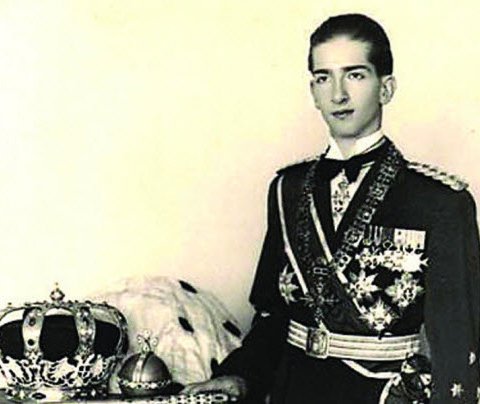 |
| King Peter II of Yugoslavia. |
the United States will speedily furnish all material assistance possible in accordance with its existing statutes. I send Your Majesty my most earnest hopes for a successful resistance to this criminal assault upon the independence and integrity of your country.The Germans already have a stranglehold on Yugoslavia, and the Italians and Luftwaffe dominate the skies, making any shipments by sea extremely unlikely.
US/Polish Relations: President Roosevelt meets with General Sikorski, leader of the Polish government in exile.
US Military: Evans Fordyce Carlson, considered a Far East specialist due to his experience in China, resigned his commission in 1939. Today, he is recommissioned at the rank of Major. Carlson has extensive experience working with Chinese Communist guerillas fighting Japanese invaders.
 |
| Joe Louis and Tony Musto at their weigh-in for their 8 April 1941 title fight (Boxing Hall of Fame in Las Vegas). |
Joe Louis knocks out Tony Musto in the Arena at St. Louis, Missouri. It is his 16th successful defense of the World Heavyweight Championship.
Future History: Margaret Anne Lennon is born in Los Angeles, California. As Peggy Lennon, she will begin appearing with her sisters Dianna Barbara, Kathy and Janet as the Lennon Sisters on the Lawrence Welk Show from 1955-1968. Peggy will continue performing with the group - which still tours as of this writing - until her retirement in 1999.
Vivienne Isabel Swire is born in Tintwistle Cheshire, near Glossop, Derbyshire. As Vivienne Westwood due to her marriage to Derek Westwood, she and her second husband Malcolm McLaren become clothes designers, with McLaren managing the Sex Pistols. When the Sex Pistols wear Vivienne's clothing, she garners a lot of attention. Westwood becomes a key mover behind the fashions of the punk movement, with a definite edge of leather bondage gear, spikes, chains and the like. She goes on to form her own fashion company, designs clothing for many celebrities such as the characters in "Sex and the City," and become politically active.As of this writing, Dame Vivienne Westwood continues to be perhaps the top fashion celebrity in England, at least in certain circles - though there are several claimants to that throne.
Darlene Faye Gillespie is born in Montreal, Quebec. She becomes famous as a child actress, appearing as a singer and dancer on the original Mickey Mouse Club television series from 1955-1958. She goes on to a singing career and various other adventures.
 |
| Earle Graser, the first radio "Lone Ranger," perishes on 8 April 1941 in an automobile accident. |
April 1, 1941: Rommel Takes Brega
April 2, 1941:Rommel Takes Agedabia
April 3, 1941: Convoy SC-26 Destruction
April 4, 1941: Rommel Takes Benghazi
April 5, 1941: Rommel Rolling
April 6, 1941: Operation Marita
April 7, 1941: Rommel Takes Derna
April 8, 1941: Yugoslavia Crumbling
April 9, 1941: Thessaloniki Falls
April 10, 1941: USS Niblack Attacks
April 11, 1941: Good Friday Raid
April 12, 1941: Belgrade and Bardia Fall
April 13, 1941: Soviet-Japanese Pact
April 14, 1941: King Peter Leaves
April 15, 1941: Flying Tigers
April 16, 1941: Battle of Platamon
April 17, 1941: Yugoslavia Gone
April 18, 1941: Me 262 First Flight
April 19, 1941: London Smashed
April 20, 1941: Hitler's Best Birthday
April 21, 1941: Greek Army Surrenders
April 22, 1941: Pancevo Massacre
April 23, 1941: CAM Ships
April 24, 1941: Battle of Thermopylae
April 25, 1941: Operation Demon
April 26, 1941: Operation Hannibal
April 27, 1941: Athens Falls
April 28, 1941: Hitler Firm about Barbarossa
April 29, 1941: Mainland Greece Falls
April 30, 1941: Rommel Attacks
2020



